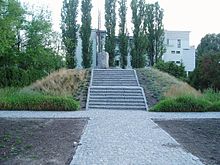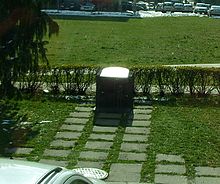- Miła 18
-
Ulica Miła 18 (or 18 Pleasant Street in English) was the headquarters "bunker" (actually a shelter) of the ŻOB, a Jewish resistance group in the Warsaw Ghetto in Poland during World War II. Nowadays a monument to the resistance leader Mordechaj Anielewicz stands there.
The bunker at Miła 18 was constructed by a group of underworld smugglers in 1943. The ŻOB arrived there by coincidence, and it became the tactical headquarters for the Warsaw Ghetto Uprising. The smugglers who had built it helped the ŻOB as guides.
On 8 May 1943, three weeks after the start of the Uprising, when the "bunker" was attacked by the Nazis, there were 300 people inside. The smugglers surrendered, but the ŻOB command, including Mordechaj Anielewicz, the leader of the Uprising, stood firm. German and Ukrainian troops threw tear gas into the shelter to force the occupants out. Anielewicz, his wife and many of his staff committed mass suicide rather than surrender, though a few fighters managed to get out of a rear exit.
Although it is often claimed that Miła 18 was the last shelter in the Ghetto to fall, this was not the case (according to Jürgen Stroop, his men took 30 "bunkers" on 12 May alone). It should be also noted that the current street numbering in Mila Street does not correspond to the wartime numbering: the current Miła 18 is an apartment block in a different location.
See also
References
External links
Categories:- 1943 establishments
- Buildings and structures in Warsaw
- History of Warsaw
- Jewish resistance during the Holocaust
- Jewish Polish history
- Mass suicides
- Monuments and memorials in Poland
- Visitor attractions in Warsaw
Wikimedia Foundation. 2010.


